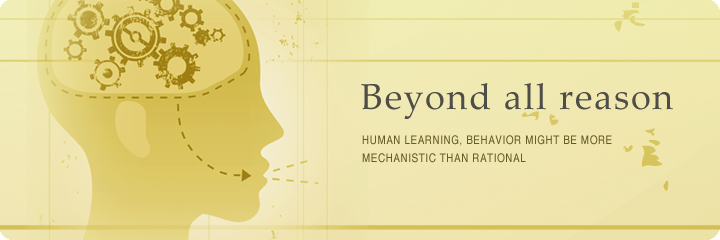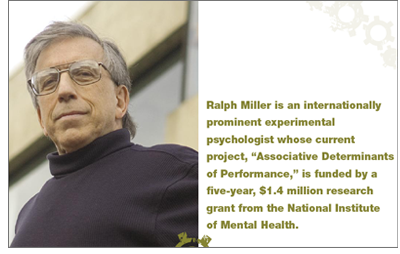
People might have a lot more in common with Pavlov’s dogs than any of us would care to think. Learning might be a far more mechanical, even automatic, process than most of us — most notably modern-day educators — dare to imagine. And even if a student can’t recite the times tables, that doesn’t mean he didn’t “learn” them.
These rather startling assertions only hint at the profound implications of a growing body of work by Ralph R. Miller, distinguished professor of psychology. Miller’s work, which for more than 37 years has earned continuous federal sponsorship, deals both with animal conditioning and human decision making. It is opening new windows on understanding the complex cognitive processes involved in acquiring, retrieving and using information to make decisions. And it is calling into question the common belief that human behavior is a function of rational thought.
“We don’t think the view of the rational mind as the
basis of behavior is illuminating,” Miller explains. And even
if there is such a thing as rational thought, there is certainly
no good explanation for how exactly it works.
In fact, assertions about the rational mind, Miller says, often
amount to variations on the Homunculus Argument, which attempts
to explain thought and behavior by positing that we have in our
head an agent capable of rational thought — essentially a “little
person,” or homunculus, who helps us make choices and reason
our way through life. Most psychologists and philosophers have disavowed
such accounts on the premise that to explain rational thought in
such a way is circular reasoning.
Rather than defer to our ability to reason, Miller studies the cognitive
mechanisms and processes underlying reasoning in humans and animals.
Miller is an internationally prominent experimental psychologist whose current project, “Associative Determinants of Performance,” is funded by a five-year, $1.4 million research grant from the National Institute of Mental Health.
But he is probably best known for establishing the foundation of temporal coding theory. While the name sounds off-putting, it is essentially a theory rooted in the proposition that the human mind is mechanistic rather than rational — that what goes on in it can be explained through physical and biological causes, many of which hinge on the timing of sensory input we receive.
In essence, temporal coding theory suggests that in Pavlovian conditioning or associative learning, the timing of stimuli in connection to one another is not just important but integral to the association that results. In other words, receiving the food soon after the bell goes off doesn’t just catalyze learning. The contiguity or timing of these two events in relation to each other is actually encoded as part of the association. This theory is a radical departure from traditional views and has helped over the past two decades to change the direction of research in the field of associative learning.
 Miller’s theory also takes another dramatic step away from
traditional thinking concerning the role of rewards and punishments,
and asserts that if the timing between the conditioned response
and the unconditioned response is close enough, nothing more is
needed for anassociation to be made. Good contiguity, it says, is
sufficient for the formation of an association.
Miller’s theory also takes another dramatic step away from
traditional thinking concerning the role of rewards and punishments,
and asserts that if the timing between the conditioned response
and the unconditioned response is close enough, nothing more is
needed for anassociation to be made. Good contiguity, it says, is
sufficient for the formation of an association.
It also asserts that temporal coding is critical in determining
what behavior a cue will elicit, or if and when the
behavior is elicited, and perhaps more important, that temporal
information from independent episodes can be integrated to effectively
create an association between two disparate events, events that
were never directly paired.
For example, if rats learn that pressing a lever produces a tone and, subsequently, with the lever removed, hear the tone right before they are fed, as soon as the lever is reintroduced, they press it with radically increased frequency. Presumably, they’ve associated the tone with the delivery of food and have arrived at the conclusion that the lever causes the tone and that pressing it will get them more food, even though there was no direct association between the food and the lever. This is just one of the many experiments in which Miller has explored how humans and rats attribute causality, or the relationship between cause and effect. While rats differ from humans in their approaches to complex tasks, there is little difference across the species in terms of such basic processes as influence-associative learning and causal judgments, he said.
page 1 | page 2